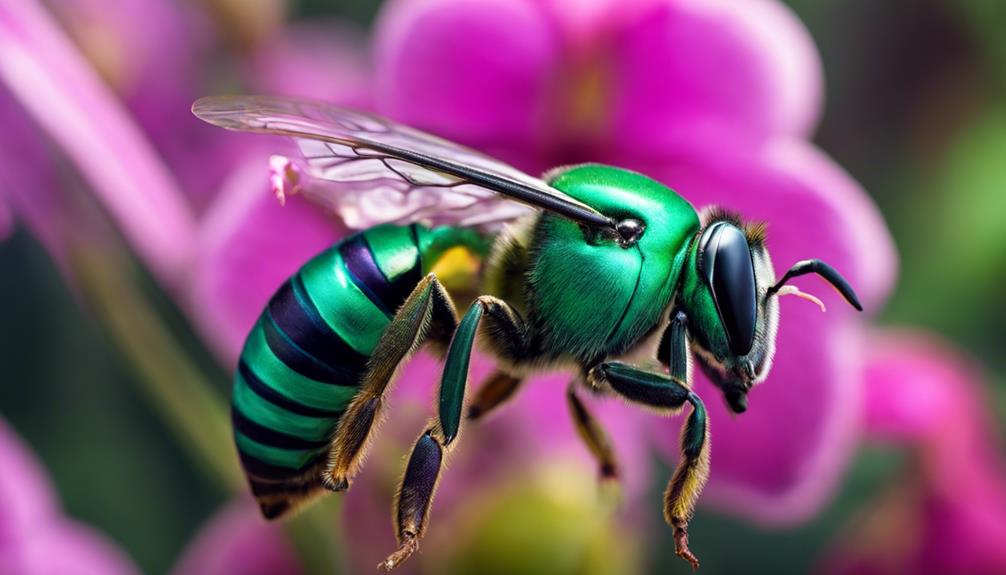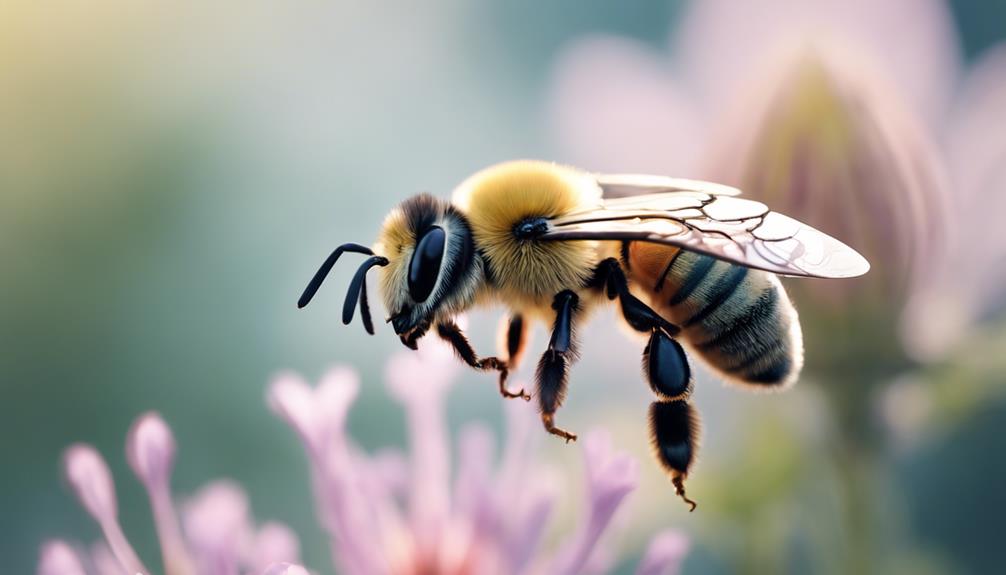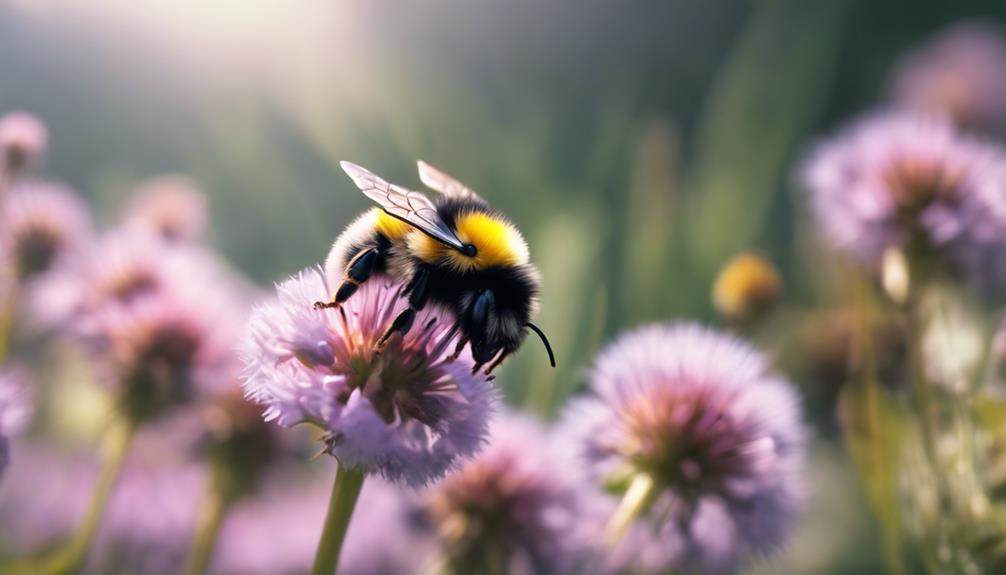In the realm of bees, we’ve found that Italian Honey Bees, Mason Bees, Carniolan Bees, and Caucasian Mountain Gray Bees are among the gentlest. Italian Honey Bees are calm and favored by beekeepers, showing little inclination to cause trouble unless provoked. Mason Bees, conversely, are solitary, effective flower visitors with a gentle nature, making them a great option even for novices in beekeeping. These bees display kind behavior towards humans and play a significant role in pollination. Intrigued to learn more about these captivating bee species and their distinct qualities?
Main Points
- Italian Honey Bees are known for their docile nature and are popular among beekeepers.
- Mason Bees are solitary, gentle, and efficient pollinators.
- Carniolan Bees and Caucasian Mountain Gray Bees exhibit peaceful behavior.
- Stingless bees use biting and propolis for defense, not stinging.
- Protecting bees through conservation efforts is crucial for ecosystem balance.
Characteristics of Stingless Bees
Stingless bees, members of the Meliponini family, exhibit a unique set of characteristics due to their lack of stingers, setting them apart from other bee species. These gentle creatures are known for their peaceful demeanor, making them one of the most important bee species.
Without the ability to sting, stingless bees have developed fascinating defense mechanisms to protect their colonies. Instead of relying on stingers, they use other methods such as biting, propolis, and even recruiting soldier bees to fend off threats.
Despite not having a traditional stinger, stingless bees play a vital role in pollination and maintaining ecosystem health. Their gentle nature and inventive defense strategies make them a fascinating and valuable part of the natural world.
Behavior Towards Humans
When interacting with humans, Italian Honey Bees demonstrate a remarkable level of docility and non-aggressiveness compared to other bee species. Their gentle nature shines through as they go about their business, showing little interest in causing harm unless provoked. This makes Italian Honey Bees a popular choice for beekeepers seeking a peaceful coexistence.
Unlike some bee species, Italian Honey Bees prefer to stay close to home, reducing the chances of any aggressive encounters with humans. Their docile and non-aggressive behavior sets them apart, making them a favored option for those looking to keep bees without the worry of frequent stings.
Choosing Italian Honey Bees can lead to a harmonious relationship between humans and these incredible pollinators.
Reproduction and Nesting Habits

Our discussion on the reproductive and nesting habits of the Mason Bee sheds light on its unique solitary nature and gentle behavior, setting it apart as the least aggressive bee species.
Mason Bees, such as those in the Osmia genus, exhibit fascinating nesting habits by laying their eggs in hollow stems and sealing their nests with mud. This meticulous process not only showcases their non-aggressive behavior but also highlights their resourcefulness in providing a safe environment for their offspring.
Female Mason Bees, the only ones with stingers, use them sparingly, typically when provoked, while the male counterparts, lacking stingers, contribute to the overall peaceful nature of these bees.
Their choice of nesting locations, like bee hotels, further emphasizes their gentle and non-threatening characteristics, making them a valuable addition to any ecosystem.
Unique Defense Mechanisms
Stingless bees may not pack a sting, but that doesn’t mean they can’t defend their hives with finesse. These tiny creatures have mastered the art of protection through biting, mandibles, and even chemical warfare.
Their peaceful pollination methods and ingenious defense strategies showcase nature’s brilliance in the most unexpected ways.
Gentle Bee Behavior
Among the various bee species renowned for their gentle behavior, Carniolan bees stand out as one of the calmest and most docile. Italian bees also exhibit a gentle nature, making them a great choice for new beekeepers.
On the other hand, Caucasian Mountain Gray bees are known for their peaceful behavior, rarely showing signs of aggression. These bees are like the zen masters of the bee world, spreading tranquility wherever they go.
It’s fascinating how different bee species have their own unique personalities and ways of interacting with the world. Whether it’s the docile Carniolan bees, the gentle Italian bees, or the peaceful Caucasian Mountain Gray bees, each brings something special to the hive and the beekeeping community.
Non-Aggressive Hive Protection
When considering non-aggressive hive protection and unique defense mechanisms, it’s fascinating to observe how Carniolan bees showcase their gentle nature through adaptability and resource conservation.
These bees are masters at maintaining a peaceful hive environment while effectively safeguarding their colony. Carniolan bees, with their non-aggressive behavior, have a remarkable ability to adjust the size of their hive in response to changing conditions, ensuring best use of honey stores and resources without unnecessary aggression.
This unique defense mechanism not only highlights their intelligence but also contributes to their reputation as one of the least aggressive bee species. Beekeepers appreciate the Carniolan bees’ harmonious approach to hive protection, as they manage to defend against pests without displaying excessive defensiveness.
Their docile nature and strategic defense strategies make them an ideal choice for those seeking a tranquil and efficient beekeeping experience.
Peaceful Pollination Methods
Observing the gentle nature of Carniolan bees in hive protection, it’s fascinating to investigate the distinctive defense mechanisms utilized by stingless bees for peaceful pollination. Here are some intriguing methods these bees employ:
- Biting: Instead of stinging, stingless bees resort to biting as a defense mechanism, allowing them to ward off threats without causing harm.
- Propolis Spraying: Stingless bees produce propolis, a sticky substance derived from plant resins, which they spray on intruders to immobilize them and protect their colony.
- Swarming: When faced with a predator, stingless bees swarm around the intruder, creating a buzzing mass that confuses and deters the threat effectively.
- Coordinated Efforts: Stingless bees exhibit remarkable teamwork in defending their hive, showcasing a harmonious and organized approach to safeguarding their home while peacefully pollinating their surroundings.
Role in Pollination
Playing an essential role in pollination, the Mason Bee stands out as the least aggressive bee known for its gentle nature and efficient flower-visiting habits. These bees are like the peaceful gardeners of the insect world, buzzing from flower to flower with a calm demeanor.
Their pollination efficiency is impressive, as they zip around gardens and orchards, visiting numerous blooms in a short span. It’s fascinating how Mason Bees carry pollen on their underbellies, aiding in the cross-pollination important for fruit production.
Their gentle nature makes them welcome guests in agricultural settings, where they contribute to sustainable practices. With their unassuming yet important role in pollination, Mason Bees show us that even the smallest creatures play a significant part in nature’s grand tapestry.
Comparison to Other Bee Species

When comparing Italian Honey Bees to other bee species, it’s fascinating to note their gentle demeanor. Among bee species, Italian Bees stand out for their non-aggressive behavior and reduced likelihood of stinging humans.
This makes them a top choice for beekeepers seeking a more amiable partner in their beekeeping endeavors.
Gentleness Among Bee Species
Among bee species, the mildness of Italian Honeybees stands out, making them a popular choice for beginner beekeepers due to their non-aggressive nature. Here are some comparisons with other bee species to give you a broader perspective:
- Russian Honeybees: Recognized for their resistance to varroa mites, these bees can be a valuable asset to beekeepers. However, they may be difficult to acquire in certain regions.
- Carniolan Honeybees: Regarded as one of the most peaceful bee species, Carniolan Honeybees flourish in colder climates, making them ideal for beekeepers in chilly regions.
- Caucasian Mountain Gray Bees: These bees are exceptionally mild and typically avoid swarming, making them well-suited for environments with diverse flora.
Each bee species has its unique characteristics, but Italian Honeybees’ mild nature makes them a top choice for those starting their beekeeping journey.
Behavior Towards Humans
Given the mild nature of Italian Honeybees compared to other bee species, their behavior towards humans is significantly less aggressive. These bees exhibit a gentle nature, making them a preferred choice for beekeepers and those who seek a harmonious coexistence with these fascinating insects.
Italian Honey Bees have a low inclination to sting, prioritizing hive activities over defensive actions. This characteristic not only sets them apart from more aggressive bee species but also makes them an excellent option for beginners in beekeeping. Their calm demeanor and focus on hive maintenance contribute to a peaceful interaction with humans, fostering a sense of safety and tranquility.
Choosing Italian Honey Bees can enrich your beekeeping experience by providing a less confrontational and more enjoyable relationship with these remarkable creatures.
Environmental Impact and Conservation
Conserving bee habitats and promoting bee-friendly practices are essential steps in safeguarding the environment’s biodiversity and stability.
- Plant native flowers: By planting native flowers in our gardens, we provide bees with a diverse and abundant source of nectar and pollen.
- Avoid pesticides: Opt for natural pest control methods to protect bees from harmful chemicals that can impact their health and population.
- Create bee hotels: Setting up bee hotels can offer shelter for solitary bees, supporting their nesting and reproduction.
- Spread awareness: Educating others about the importance of bees and the actions we can take to support their conservation efforts is key to ensuring their survival.
Together, these practices can help protect bees and preserve the crucial role they play in our ecosystems.
Geographic Distribution

Italian honeybees, known for their gentle demeanor, can be found in various regions around the world. Their adaptability to different climates allows them to flourish in diverse environments.
This geographic distribution highlights the widespread impact of their gentle behavior within hives.
Bee Species Locations
Bee species exhibit varying geographic distributions, with Africanized Honey Bees mainly prevalent in warmer states like Texas, California, and Florida.
Here’s a snapshot of where you can find some bee species buzzing around:
- Africanized Honey Bees: Enjoy the sunny vibes of states like Texas, California, and Florida.
- Bumble Bees: Spread their wings across all 50 states, with a buzzing 26 species calling California home sweet home.
- Carpenter Bees: Seek out cozy spots in regions where they can find suitable wood structures to make their nests.
- Fun Fact: Africanized Honey Bees prefer the warmth and steer clear of colder climates, making them true sun-seekers!
Regional Bee Behavior
Investigating the regional behavior of bees uncovers captivating insights into how climate influences their aggression levels. Bees in cooler climates tend to be less hostile, like the Carniolan honeybee and Caucasian Mountain Gray Bees. These bees have a reputation for their mild nature, making them a favorite among beekeepers.
Italian honeybees also distinguish themselves for their gentle and non-hostile behavior, making them an excellent choice for beginners. The Russian honeybee, recognized for its thriftiness in honey consumption, is another example of a bee species that isn’t inclined towards aggression.
Understanding how different bee species adapt to their environments helps us value the diverse behaviors and characteristics that enable these intriguing creatures to prosper in various regions.
Gentleness in Hives
Amid various geographical areas, the revelation of tenderness in colonies among different bee species exposes captivating insights into their adaptability and behavior.
- Italian honeybees, with their gentle nature, bring a sense of calm to their hives, making them a popular choice for beekeepers seeking docile bees.
- Their preference for staying within the hive rather than swarming contributes to their peaceful demeanor, reducing the likelihood of aggressive behaviors.
- Beginners in beekeeping often find Italian honeybees ideal due to their calm temperament and adaptability to various climates.
- As a subspecies of the Western honeybee, Italian honeybees not only excel as honey producers but also exhibit non-aggressive characteristics, particularly beneficial for beekeepers in colder regions.
Interactions With Plants

In our observations, we’ve noticed that bumblebees interact with plants in a delicate and important manner. These gentle creatures play a critical role in pollinating various plants and crops, contributing to ecosystem biodiversity.
As they buzz from flower to flower, their gentle nature is evident in the way they delicately collect nectar without causing harm. Bumblebees create vibrations while foraging, aiding in the pollination of flowers and fruits, ensuring the reproduction of many plant species. Their long tongues allow them to access nectar from deep flowers, showcasing their specialized adaptation for this essential task.
Through their interactions with plants, bumblebees not only support food production but also help maintain the balance and beauty of our natural world.
Beekeeping Potential and Challenges
Bumblebees’ crucial role in pollinating plants naturally leads to reflections on beekeeping potential and challenges. When considering beekeeping, the gentle nature of the Italian honeybee stands out as a significant advantage.
Here are some key points to keep in mind about the Italian honeybee and beekeeping:
- Italian Honeybees: Known for their adaptability and large colonies, Italian honeybees are favored by beekeepers.
- Gentle Nature: Their docile behavior and minimal swarming tendencies make them ideal for beginners.
- Beekeeping Benefits: Italian honeybees are less likely to sting and are excellent foragers, making them valuable assets in a hive.
- Ease of Management: Beekeepers appreciate the calm demeanor of Italian honeybees, which simplifies hive maintenance.
These characteristics make the Italian honeybee a popular choice for those venturing into the world of beekeeping.

Roger Thomas is a seasoned beekeeper and hive architect with a deep-seated passion for sustainable living. His fascination with bees has shaped his professional career, giving him practical and theoretical expertise in bee behavior, colony health, and optimal hive conditions. Roger’s technical skills shine in his bespoke hive creations that cater to the specific needs of diverse bee species, while his sustainable practices promote environmental balance and the wellbeing of the bee population.
As he continues his journey in beekeeping, Roger has become a dedicated advocate for responsible practices and an insightful educator in his field. His posts aim to inspire new beekeepers, underline the importance of sustainability, and showcase the remarkable contribution bees make to our ecosystem. Roger invites you to join him as he delves into the world of bees and the rewarding, honey-sweet art of beekeeping.


